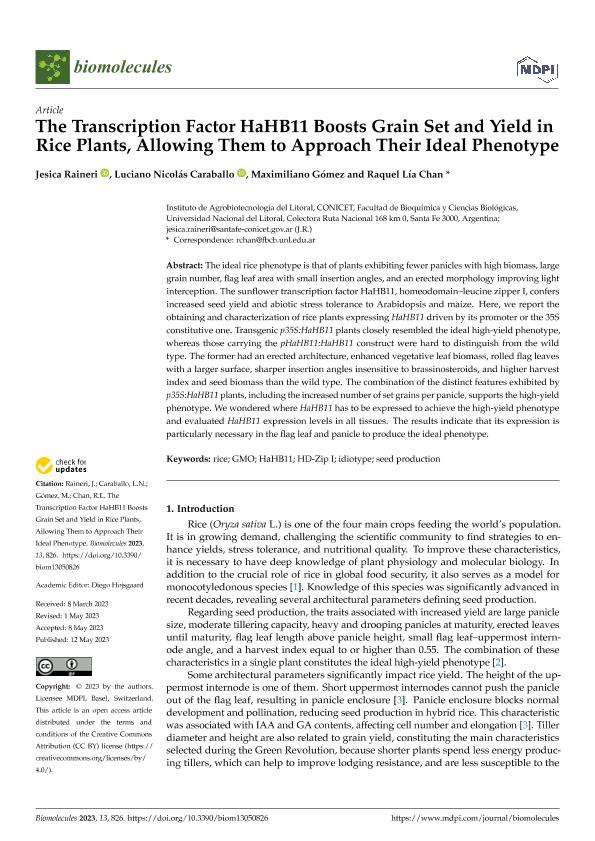Artículo
The Transcription Factor HaHB11 Boosts Grain Set and Yield in Rice Plants, Allowing Them to Approach Their Ideal Phenotype
Fecha de publicación:
05/2023
Editorial:
MDPI
Revista:
Biomolecules
ISSN:
2218-273X
Idioma:
Inglés
Tipo de recurso:
Artículo publicado
Clasificación temática:
Resumen
The ideal rice phenotype is that of plants exhibiting fewer panicles with high biomass, large grain number, flag leaf area with small insertion angles, and an erected morphology improving light interception. The sunflower transcription factor HaHB11, homeodomain–leucine zipper I, confers increased seed yield and abiotic stress tolerance to Arabidopsis and maize. Here, we report the obtaining and characterization of rice plants expressing HaHB11 driven by its promoter or the 35S constitutive one. Transgenic p35S:HaHB11 plants closely resembled the ideal high-yield phenotype, whereas those carrying the pHaHB11:HaHB11 construct were hard to distinguish from the wild type. The former had an erected architecture, enhanced vegetative leaf biomass, rolled flag leaves with a larger surface, sharper insertion angles insensitive to brassinosteroids, and higher harvest index and seed biomass than the wild type. The combination of the distinct features exhibited by p35S:HaHB11 plants, including the increased number of set grains per panicle, supports the high-yield phenotype. We wondered where HaHB11 has to be expressed to achieve the high-yield phenotype and evaluated HaHB11 expression levels in all tissues. The results indicate that its expression is particularly necessary in the flag leaf and panicle to produce the ideal phenotype.
Palabras clave:
GMO
,
HAHB11
,
HD-ZIP I
,
IDIOTYPE
,
RICE
,
SEED PRODUCTION
Archivos asociados
Licencia
Identificadores
Colecciones
Articulos(IAL)
Articulos de INSTITUTO DE AGROBIOTECNOLOGIA DEL LITORAL
Articulos de INSTITUTO DE AGROBIOTECNOLOGIA DEL LITORAL
Citación
Raineri, Jesica; Caraballo Maillet, Luciano Nicolás; Gomez, Maximiliano; Chan, Raquel Lia; The Transcription Factor HaHB11 Boosts Grain Set and Yield in Rice Plants, Allowing Them to Approach Their Ideal Phenotype; MDPI; Biomolecules; 13; 5; 5-2023; 1-18
Compartir
Altmétricas




